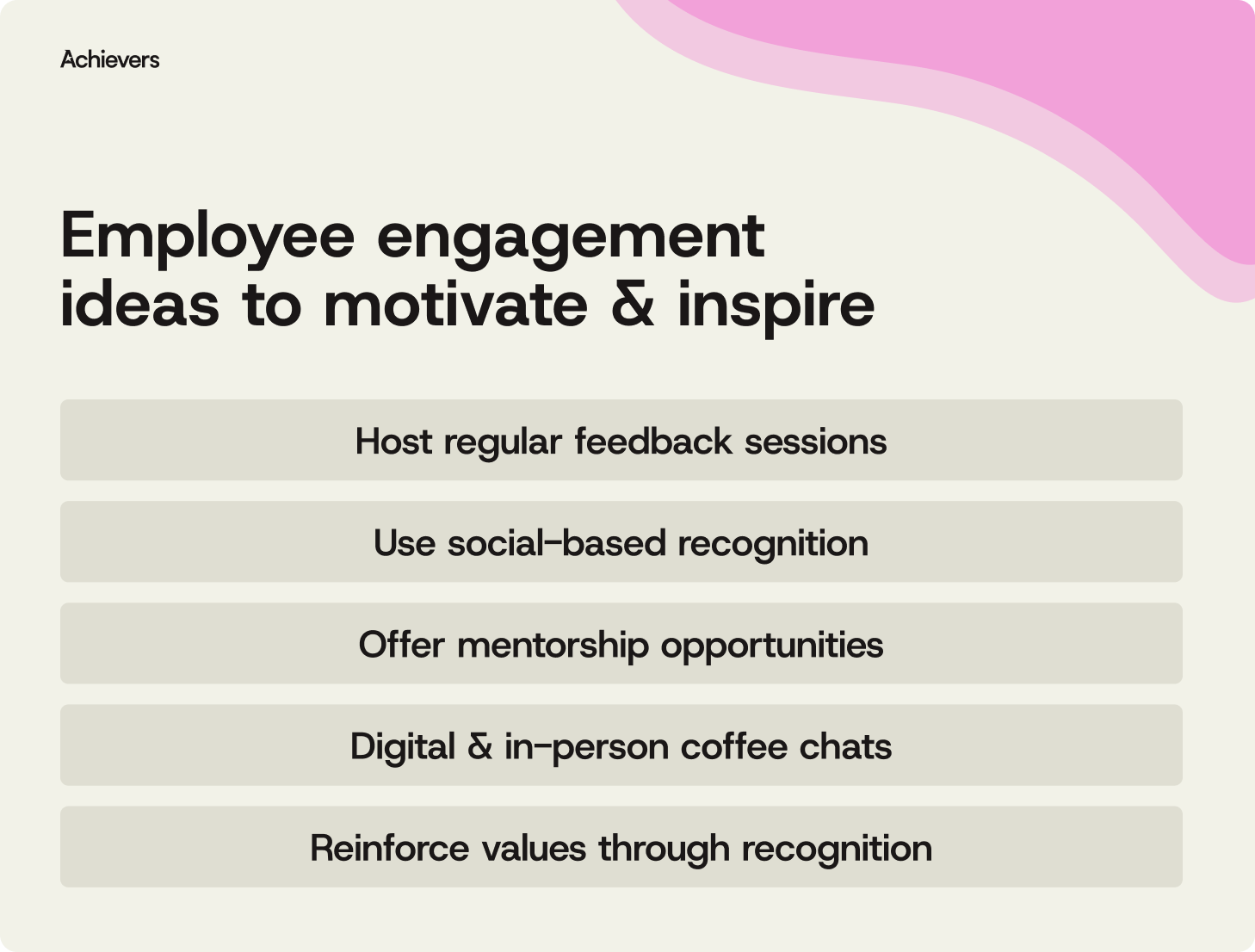Table of contents
Create a culture that means business™
Schedule a demo with an Achievers solution expert today.
Great cultures don’t happen by accident — they’re built on thoughtful employee engagement ideas that encourage real connection.
And when people feel connected to their work, their team, and their impact? That’s when the real results start to show.
In fact, Gallup estimates that a fully engaged global workforce could unlock $9.6 trillion in productivity. You read that right — trillion with a T.
That’s why we’ve rounded up 39 employee engagement ideas designed to shape culture, spark motivation, and drive real results — wherever your people work.
39 employee engagement ideas to motivate teams
There’s no one-size-fits-all approach to engagement — but some ideas just work. These are the ones that help people feel connected, valued, and motivated to bring their best, every day. These ideas are practical, proven, and ready to put into action.

Communication and feedback
These ideas open the door to honest conversations, build trust, and make feedback feel like a natural part of your culture.
1. Use employee surveys
Consistent, quarterly surveys give you a real-time pulse on how employees are feeling — and why. Keep them short, actionable, and transparent so employees know their voice matters and their input actually leads to change.
2. Collect feedback with an AI chatbot
Let employees share what’s on their minds anytime — no meeting required. An always-on chatbot gives people a low-pressure way to give feedback for managers, flag concerns, or answer pulse questions, all in the flow of work.
3. Encourage ongoing feedback
If you want feedback, ask for it — and then prove you mean it. Open up channels, show people their input drives change, and skip the suggestion box black hole. Nothing says “we care” like actually listening.
4. Act on employee input
The fastest way to kill your best engagement idea? Collecting feedback and doing nothing with it. Close the loop by sharing results, identifying themes, and making visible improvements. Even small changes go a long way — and according to Achievers Workforce Institute’s Engagement and Retention Report, acting on feedback boosts trust in company leaders by 75% more than collecting feedback alone.
5. Keep employees informed
Don’t make employees rely on the grapevine. Regular updates — across multiple channels — keep everyone in the loop and help people see how their work connects to the bigger picture. Transparency builds trust.
6. Host regular feedback sessions
Normalize giving and receiving feedback through regular check-ins. Whether it’s one-on-ones, skip levels, or structured conversations, it’s all about building a habit — because no one’s best feedback ever started with “let’s circle back in Q4.
7. Foster transparent communication
Open the floor with AMAs, town halls, or Q&As that invite candid questions and honest answers. It’s a powerful way to build trust — and maybe settle the great return-to-office debate once and for all.
8. Offer virtual office hours
“Open door” policies don’t mean much if no one knows when the door’s open. Virtual office hours give employees a clear path to connect with leaders — casually, candidly, and without a calendar fight.
Recognition and appreciation
Want people to keep doing great work? Recognize it. Recognition is one of the simplest — and most powerful — ways to shape behavior, build employee connection, and reinforce what “good” looks like across your culture. Here’s how:
9. Recognize achievements in real time
When you call out great work as it happens, employees know their efforts matter — not just when the results roll in, but in the moment they’re made. Don’t wait for the annual review; give credit while the tab is still open.
10. Encourage peer-to-peer recognition
Empowering teams to recognize each other strengthens relationships, boosts morale, and creates a workplace culture where appreciation is everyone’s responsibility. Plus, there’s something extra powerful about a “you crushed it” from someone in the trenches with you.
11. Offer personalized employee rewards
T-shirts fade. Points-based rewards, on the other hand, let employees choose what’s meaningful to them — whether that’s a weekend getaway, new headphones, or just a gift card that doesn’t go straight in the junk drawer.
12. Recognize values-based behavior
When someone shows up in a way that reflects your company’s values, say it out loud. This turns recognition into a culture-building tool — and helps bring those values down from the wall and into everyday work.
13. Celebrate individual accomplishments
It’s not just about promotions and product launches. Certifications, speaking gigs, side projects — when you recognize the full person behind the job title, you send a powerful message: we see you.
14. Celebrate employee milestones and team wins
Big or small, milestones deserve the spotlight. Whether it’s a work anniversary, a team goal, or just making it through a tough week, build in moments to celebrate. It reinforces progress — and adds a little joy along the way.
15. Launch nomination-based employee awards
Nomination-based awards are a powerful way to surface meaningful stories and recognize the everyday heroes who rarely get time in the spotlight. No red carpet required — unless you really want to.
16. Send casual thank-you notes and shoutouts
Not every thank-you needs a trophy. Quick notes, shoutouts, or a well-timed “you did great” go a long way in making recognition part of the rhythm of work.
Growth and development
If you want employees to stay, give them room to grow. These are the engagement ideas that help build a culture of curiosity, mobility, and longevity:
17. Support employee development
Investing in employee development is one of the best ways to build loyalty. Whether it’s learning a new skill, attending a workshop, or pursuing a certification, growth opportunities show your people they’re worth the time and budget.
18. Offer professional training and workshops
Growth doesn’t happen in a vacuum. Bring in guest speakers, host lunch-and-learns, or launch a workshop series to sharpen skills and spark new thinking. Bonus points if it gets people out of their inboxes.
19. Provide mentorship opportunities
The best growth stories are co-written. Pair employees with mentors who can help them navigate challenges, build confidence, and chart their career path. It’s development — with a human touch.
20. Encourage cross-departmental collaboration
Siloed work slows everything down. Create opportunities for people to shadow different teams, collaborate on cross-functional projects, or participate in short-term swaps. It’s a smart way to build skills and unlock hidden talent.
Workplace experience
Great workplace cultures are built on trust, flexibility, and the sense that your employer actually sees you as a human — not just a job title. It’s the foundation that motivates teams to do their best work — and inspires them to go above and beyond, again and again.
21. Prioritize work-life balance
Support flexible schedules, set healthy boundaries, and make space for people to step away when they need to. The more balance employees have, the more likely they are to bring their best selves to the table (instead of just logging in on fumes).
22. Establish an employee wellness program
Wellness programs, from mental health resources to hydration challenges, help people bring their best selves to work. And no, “wellness” doesn’t just mean free yoga mats (though those don’t hurt either).
23. Offer flexible work arrangements
When people have the freedom to manage their time and space, they’re more focused, more energized, and more likely to stay engaged. Rigid 9-to-5s are out. Autonomy is in.
24. Create a comfortable, inclusive workspace
If your office still feels like a sea of gray cubicles and fluorescent lights, it might be time for a refresh. Inclusive, human-centered spaces — whether physical or virtual — help people feel like they belong. And no, beanbags aren’t a substitute for belonging.
25. Let employees give back
Support the causes your employees care about by offering volunteer hours, donation matching, or team-led giveback initiatives. It builds connection, fosters pride, and proves your values stretch beyond the company’s four walls — assuming you even have walls.
26. Support employee passions
Let your people geek out. Encourage time for personal projects, creativity, and exploration — because a little room to pursue what lights them up? That’s how you get more innovation, less burnout in the workplace, and the occasional surprisingly great idea over lunch.
Fun and connection
The strongest employee engagement ideas don’t just focus on productivity or performance. Think of these ideas as your culture glue: the small moments that build friendships, boost morale, and make Mondays a little less… Monday.
27. Team-building activities
Strong teams don’t happen by accident. Plan activities — like escape rooms, cooking classes, or collaborative challenges — that build trust, communication, and the occasional inside joke. Bonus points if nobody gets stuck doing a trust fall.
28. Digital socials and coffee chats
Remote employees need connection too — beyond project syncs and Slack threads. Schedule virtual coffee chats, themed hangouts, or just some unstructured time to catch up. Because even remote teams deserve a little watercooler magic.
29. Friendly competitions
Bring out some healthy rivalry with fun contests — trivia, desk decorating, bake-offs, or even meme-of-the-week. Keep it light, keep it inclusive, and maybe keep a scoreboard. Bragging rights are powerful motivators.
30. Host social events
Sometimes the best way to build connection is to step away from the work entirely. Host lunches, team parties, or casual get-togethers to create space for real conversations — no agenda, no KPIs, just people.
31. Plan fun for remote teams
Make fun feel accessible from anywhere. Virtual scavenger hunts, movie nights, online talent shows, or remote cooking classes give distributed teams a reason to log in — and actually enjoy it.
32. Try icebreakers, games, and movement breaks
Start meetings with a quick game, a quirky question, or a walk around the block. These low-lift moments shake up the routine, lower the pressure, and help people show up as humans — not just job titles.
33. Offer meditation and fitness challenges
Support wellness and connection at the same time with guided meditation sessions or team-based fitness challenges. Nothing builds camaraderie quite like collectively trying (and failing) to hold a plank for 60 seconds.
Culture alignment
The best employee engagement ideas won’t stick if they’re not a part of the right culture. Here’s how to build a culture that actually supports the engagement you’re aiming for:
34. Appoint the right leaders
Employee engagement starts at the top. Choose leaders who model your values, communicate clearly, and actually inspire people (not just manage them). A great manager can make or break the employee experience — and often, the team’s performance too.
35. Hire for culture fit
Skills can be trained — values alignment, not so much. Hire people who reflect your culture and add something new to it. It’s how you keep things consistent without going stale.
36. Define and live your values
If your company values sound great in theory but don’t show up in practice, employees will notice — and disengage. Make sure your values are visible, actionable, and deeply embedded in how decisions get made.
37. Reinforce values through recognition
Tie recognition directly to behaviors that reflect your core values. It’s one of the fastest ways to make those values real — and remind people what “great work” actually looks like.
38. Support employee resource groups (ERGs)
ERGs create space for connection and community among people with shared experiences or identities — and offer on-the-ground insights into what inclusion really looks like. Create them, fund them, and listen to them.
39. Gamify cultural initiatives
Introduce fun, lighthearted competitions and team-based challenges to build camaraderie and momentum. Culture doesn’t have to be serious to be effective — sometimes, a little friendly competition goes a long way.
Bring your engagement ideas to life with recognition
All the best engagement ideas in the world won’t matter if they stay stuck in a slide deck. Turning intention into impact takes more than good planning — it takes the right platform. That’s where Achievers comes in.
We take your ideas and give you a platform to turn them into everyday action. Here’s how:
- Make recognition a daily habit: Organizations using Achievers see 2x the recognition activity compared to other platforms. Why? Because it’s designed to make appreciation fast, visible, and meaningful — from real-time shoutouts to milestone celebrations.
- Improve employee feedback and action: Achievers Voice of Employee tools surface insights in real time — from always-on surveys to AI-powered nudges — so you’re not just collecting feedback, you’re closing the loop.
- Scale employee engagement globally: Whether your workforce is remote, hybrid, or global, Achievers makes it easy to scale engagement — with delivery in 190+ countries, 200+ languages, and zero markups.
- Use AI and analytics to improve engagement: Our recognition platform offers predictive analytics, behavior-based nudges, and clear insights to help you track what’s working and course-correct fast.
The best engagement ideas are the ones you act on
There’s no shortage of employee engagement ideas out there. But the ones that make a difference? They’re the ones that are backed by culture, powered by recognition, and built to last.
Achievers gives you the tools to do more than plan. We help you build the kind of workplace where engagement shows up in every moment that matters.



